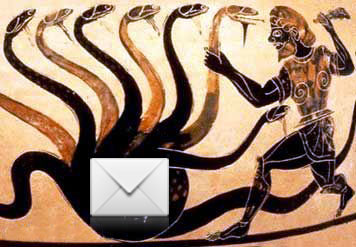About a year ago I decided to put down my thoughts concerning the dubious state of Internet mail. I made a good start, but have not found the time to complete the project. So I decided to publish this incomplete draft in the hope that this will stimulate me to finish it.
These opinions are my own. Feel free to disagree agreeably… RR
Email Manifesto
April 2014 Draft by Richard Rathe
The most dangerous thing about communication is the assumption it has occurred. — Paraphrasing George Bernard Shaw
With increased technological capability, we will substitute communication for planning. — Espen Andersen
A word, once sent abroad, flies irrevocably. — Horace
The means we use to communicate are more elegant and important than what we have to say. — Andy Rooney

Email started out as an exciting and useful tool. You could communicate with someone on the other side of the country in just a few seconds for free. It was liberating! How times have changed… Today email has morphed into a multi-headed, multi-threaded monster that many of us would love to cut down to size. It has become the lowest common denominator for electronic communication—frequently abused and massively overused.
Internet Electronic Mail (defined by documents with titles like RFC 5321 and RFC 5322) is a vestige of a more genteel age (the 1980s). Back then you would exchange email addresses with people you actually wanted to communicate with. The system was designed by and for computer-savvy professionals who trusted each other. Like nuclear scientists, these well-meaning engineers did not anticipate what would happen when their invention inevitably fell into the wrong hands.
What happens when a system based on interpersonal relationships and trust meets the faceless, predatory jungle of the global Internet? Let’s just say it hasn’t been pretty. In this manifesto I wish to call attention to the most common pitfalls and offer solutions where they exist.
Much of our pain stems from asking email to do things it wasn’t meant to do. We should simply stop using email in these situations. Other problems arise when email becomes part of office politics. Our leaders should intervene when this occurs. Finally, email is just “too damn easy” and this makes us lazy. To paraphrase Abraham Maslow, “When the only tool you know how to use is email, the solution to every problem is sending another message.” Email is a useful tool, but its utility and proper use have limits!
No Verification
For practical purposes there is no such thing as return receipt for an email message. Email standards define such a thing, but email clients have never supported it in a robust way. Clever emailers have discovered a trick with HTML-based email to track who has opened a particular message. This is considered spyware by some and is hardly a strong foundation for serious communication.
Junk Mail and Junk Mail Blockers
“Spam,” phishing, Trojans, and various other fraudulent schemes beset us on all sides. In reaction to these threats we filter out “suspicious” messages as junk mail. Or messages from certain domains may be blocked entirely. Inevitably good messages are caught up with the bad. This brings new meaning to the phrase “I’m dead to you.” Examples:
- The sender’s host may be blacklisted due to a real or hypothetical threat.
- The recipient’s host marks your messages as junk just because you include a link to a website.
- The “fuzzy logic” junk mail filter in your email client incorrectly blocks important mail from a potential client.
These events are common—often leading to bad outcomes and missed opportunities.
Problematic CCs
- Workplace politics
- Long threaded messages
- “Tag, You’re It!” Messages
 Real Work vs Answering Messages
Real Work vs Answering Messages
I was sitting in a colleague’s office the other day having a one-on-one meeting. Every five to ten minutes a little notifier box would appear on her screen with the subject line from a new email. Without even noticing she pulled her attention away from me and typed a short response. She was completely unaware how disruptive (and rude!) this was. Suddenly it became clear to me why I always felt out of the loop with her, she was using email as if it was instant messaging (IM). This may be a sequela of her past Blackberry use and the “push email” technology RIM foisted on the corporate world. It may be great for top execs who have many assistants to filter and distill email down into yes/no questions and brief FYIs. But it is pathological for anyone who has to do creative work that demands concentration over extended periods of time.
Let me be as plain as I can about this… EMAIL IS NOT IM!
IM is real-time and synchronous—I’m either available or I’m not. I can signal the sending party when I’m away, or busy, or in a meeting. The recipient is in control of when to have the conversation! Email is a poor substitute. Email is time-delayed and asynchronous. There is no way for me to say “not now” or “I’m available” throughout the day. Expecting real time response to email is presumptuous and counterproductive.
[More to Come…]
Email Cannot Substitute for Face-to-Face Meetings
“Communicating from a position of maximal ignorance.”
Notification vs Calendar Subscription
Attachments When One Line of Text Would Do
Have you ever had this experience? You receive an email about a meeting and there is nothing in the body of the message, only an attachment. You spend several seconds booting up the right program to view the attachment only to find out the meeting is being canceled. Really?! They want me to use Microsoft Word to read a one line email message?! It is absurd! They could given me everything I needed to know in the subject line.
Sending brief communications with a full featured word-processor is silly. It might make sense in a tightly controlled organization where everyone is forced to drink the corporate kool-aid. But if users provide their own infrastructure, use a Mac, use a phone, etc. this is just laziness on the part of the sender.
HTML vs Text
In the beginning there was text, all 80 columns by 24 lines of it! We were free to write simple, unadorned paragraphs. Then the world evolved to PCs and someone invented “rich text” with bold fonts and pretty colors. Suddenly the pure world of text was clouded by all that fluff. Today the trend continues. Email messages have become web pages (HTML) and every message is a potential vector for malware. To make matters worse, all these “features” are turned on by default, so new users learn bad habits right from he start. My advice? Turn all this unneeded complexity off and return to the simple, concise world of plain text!
In Praise of Plain Text
More to come…
